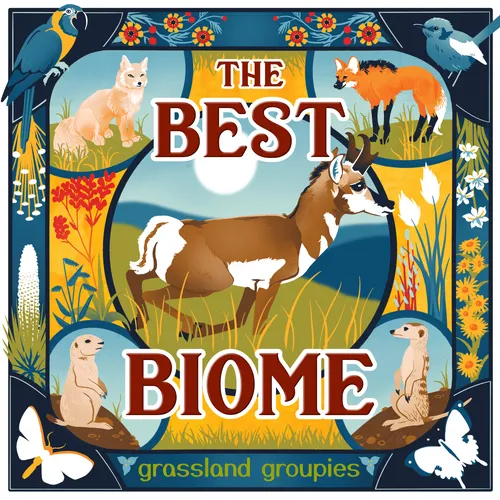
The Best Biome
a love letter to grasslands
- Update frequency
- every 17 days
- Average duration
- 60 minutes
- Episodes
- 68
- Years Active
- 2021 - 2025
![[S2E2] Hyenas: Savage Stinky Scavengers](https://b2.eachpod.com/podcast-imgs/1a90e22ee44e07787f268f741d8f520a.webp)
[S2E2] Hyenas: Savage Stinky Scavengers
CW: we talk about animal genitalia in this episode in the last 30 mins (it's hard to avoid with hyenas)
Hyenas have historically been painted in a pretty negative light, only for recent PR teams to p…
![[S2E1] Buff-necked Ibis: The Noble Bin Chicken](https://b2.eachpod.com/podcast-imgs/1a90e22ee44e07787f268f741d8f520a.webp)
[S2E1] Buff-necked Ibis: The Noble Bin Chicken
We are always fans of highlighting underappreciated animals and this week we tackle the ibis. Bin chicken or noble alarm clock? You decide. One thing's for sure: their poop is a problem. Thank you to…
![[S1E25] Disease-ridden Bloodsuckers](https://b2.eachpod.com/podcast-imgs/1a90e22ee44e07787f268f741d8f520a.webp)
[S1E25] Disease-ridden Bloodsuckers
Content Warning: talk of blood. The last of our "spooky"-themed episodes, let's talk about ticks! How do they feed, what kind of diseases do they carry, and how best to prevent getting sick from the…
![[S1E24] Vultures: Bring Out Your Dead (Part 2)](https://b2.eachpod.com/podcast-imgs/1a90e22ee44e07787f268f741d8f520a.webp)
[S1E24] Vultures: Bring Out Your Dead (Part 2)
Content Warning: talk of dead things (not graphic). Old World Vultures have a different set of tricks in order to survive including eating fruit, bones, and garbage. We talk Bearded Vultures, Eurasia…
![[S1E23] Vultures: Bring Out Your Dead (Part 1)](https://b2.eachpod.com/podcast-imgs/1a90e22ee44e07787f268f741d8f520a.webp)
[S1E23] Vultures: Bring Out Your Dead (Part 1)
Content Warning: talk of corpses and the eating of them. Vultures are nasty birds which cleanse the landscape of death and disease. In this part of our first ever two part episode we learn about the …
![[S1E22] Vampiric Plants](https://b2.eachpod.com/podcast-imgs/1a90e22ee44e07787f268f741d8f520a.webp)
[S1E22] Vampiric Plants
If you ever find yourself staring at a tangle of orange spaghetti in a grassland, it's probably a dodder plant. These talented, strange parasites have no leaves or roots, but plenty of other tricks …
![[S1E21] Chasing the Summer](https://b2.eachpod.com/podcast-imgs/1a90e22ee44e07787f268f741d8f520a.webp)
[S1E21] Chasing the Summer
A raptor like no other crosses 20,000km across hemispheres every year, chasing summer and bugs and grasslands through the Americas. The Swainson's Hawk is a spectacle, and we're grateful to have the…
![[S1E20] Grasshopper Grazing](https://b2.eachpod.com/podcast-imgs/1a90e22ee44e07787f268f741d8f520a.webp)
[S1E20] Grasshopper Grazing
How can grasshoppers save the world? By doing what they do best: eating. But too many grasshoppers might end us all so keep that in mind the next time you turn your nose up at entomophagy.
Thanks fo…
![[S1E19] The Mighty Oak Savanna](https://b2.eachpod.com/podcast-imgs/1a90e22ee44e07787f268f741d8f520a.webp)
[S1E19] The Mighty Oak Savanna
Rachel takes us on a journey into one of North America's savannas dominated by oak trees. They provide shelter and food for a variety of different animals and (surprise) are critically endangered. O…
![[S1E18] The Cunning Coyote](https://b2.eachpod.com/podcast-imgs/1a90e22ee44e07787f268f741d8f520a.webp)
[S1E18] The Cunning Coyote
Episode Notes
Coyotes are fantastic survivors that no matter how much people hate them (and boy do they hate them) they keep thriving. They are the ultimate flexitarian, can control their litter size…
![[S1E17] Pleistocene Park](https://b2.eachpod.com/podcast-imgs/1a90e22ee44e07787f268f741d8f520a.webp)
[S1E17] Pleistocene Park
The concept behind Pleistocene Park is deceptively simple: rewild the Pleistocene Siberian arctic, slow the effects of climate change in the arctic. All it takes to revive the 10,000-year-old Mammoth…
![[S1E16] Trees are Pretty Cool](https://b2.eachpod.com/podcast-imgs/1a90e22ee44e07787f268f741d8f520a.webp)
[S1E16] Trees are Pretty Cool
Episode Notes
Madagascar... land of the forest and lemurs and definitely not mostly grassland, right? Wrong. Welcome to another case of grassland erasure as we try to set the record straight on the w…
![[S1E15] Toads on Ice](https://b2.eachpod.com/podcast-imgs/1a90e22ee44e07787f268f741d8f520a.webp)
[S1E15] Toads on Ice
Episode Notes
We're going back to the Eurasian Steppe this week to take a look at the Mongolian toad. How do these toads survive where no other amphibian dares to travel? What the heck is a drink pat…
![[S1E14] Muppets on the Steppe](https://b2.eachpod.com/podcast-imgs/1a90e22ee44e07787f268f741d8f520a.webp)
[S1E14] Muppets on the Steppe
Episode Notes
Saiga antelope: strange Muppet or amazing survivor? These animals have some amazing adaptations to help them survive the nearly insurmountable odds stacked against them. Also, sandalwoo…
![[S1E13] Fruit Toss](https://b2.eachpod.com/podcast-imgs/1a90e22ee44e07787f268f741d8f520a.webp)
[S1E13] Fruit Toss
Episode Notes
THE characteristic toucan species, Toco Toucan, tucanuçu, is the only toucan that doesn't live exclusively in forests. Like many hornbills in the Old World, these birds thrive in South …

Bonus: the North American Model (a critique)
Nuance below:
We have some feelings on the North American Model and the way it's implemented and discussed in the wildlife field. It usually disparages other models of wildlife conservation, silences…
![[S1E12] Man and the Biosphere (Reserves)](https://b2.eachpod.com/podcast-imgs/1a90e22ee44e07787f268f741d8f520a.webp)
[S1E12] Man and the Biosphere (Reserves)
Episode Notes
Apparently Biosphere Reserves are everywhere? Nicole's deep dive into UNESCO's Man and the Biosphere (MAB) Programme takes several twists and turns, linking natural and social sciences,…
![[S1E11] Riverine Grasslands and the Bengal Florican](https://b2.eachpod.com/podcast-imgs/1a90e22ee44e07787f268f741d8f520a.webp)
[S1E11] Riverine Grasslands and the Bengal Florican
Episode Notes
In Assam, India, the grasslands along the river Brahmaputra totally contain tigers, but Rachel is bound and determined to talk about something hiding in the shadows of those tigers: riv…
![[S1E10] Biospheres for Horses (Takhi)](https://b2.eachpod.com/podcast-imgs/1a90e22ee44e07787f268f741d8f520a.webp)
[S1E10] Biospheres for Horses (Takhi)
Episode Notes
What has four legs and walks on its middle finger and features heavily in all your favorite childhood video games?? Horses are actually kinda neat, it turns out, especially the modern c…
![[S1E9] Two Truths and a Lie: stump the naturalist edition](https://b2.eachpod.com/podcast-imgs/1a90e22ee44e07787f268f741d8f520a.webp)
[S1E9] Two Truths and a Lie: stump the naturalist edition
Episode Notes
In an April 1 break from the normal format, Nicole and Rachel try to stump each other with a game of Two Truths, One Lie. Buckle up for carnivorous prairie plants, Saiga death by bangin…